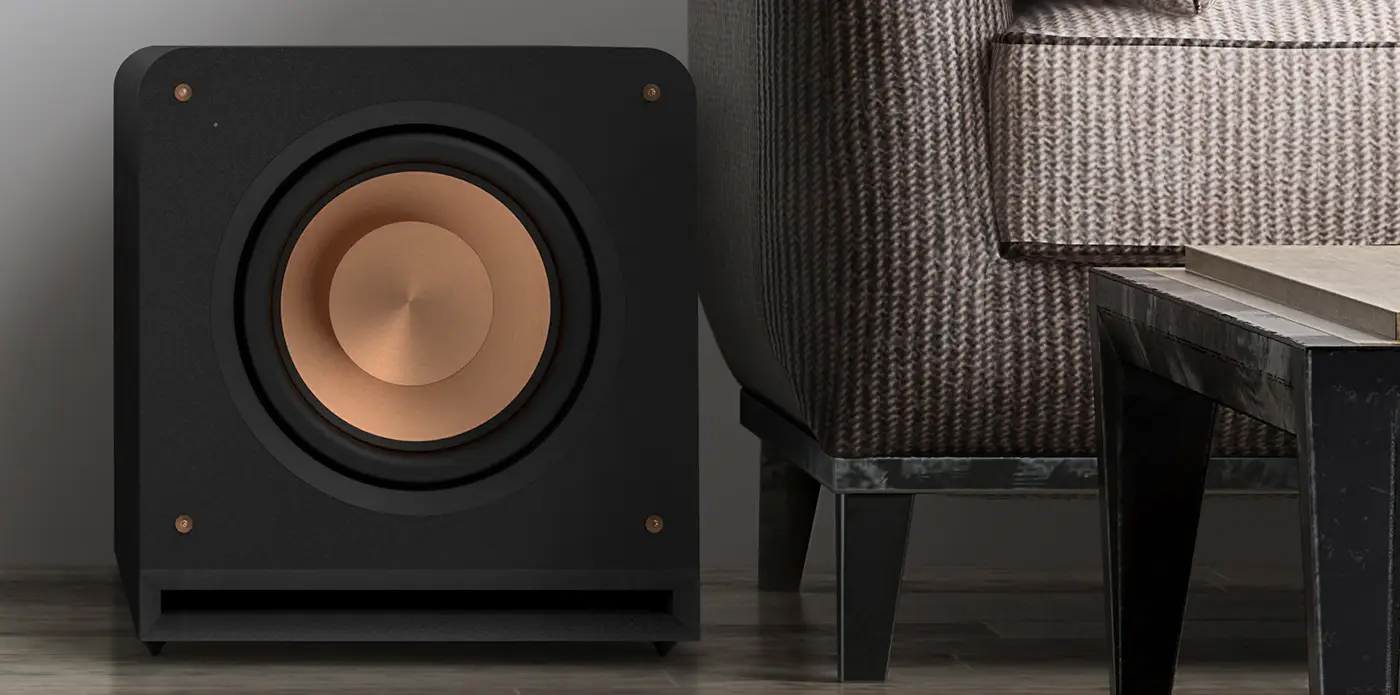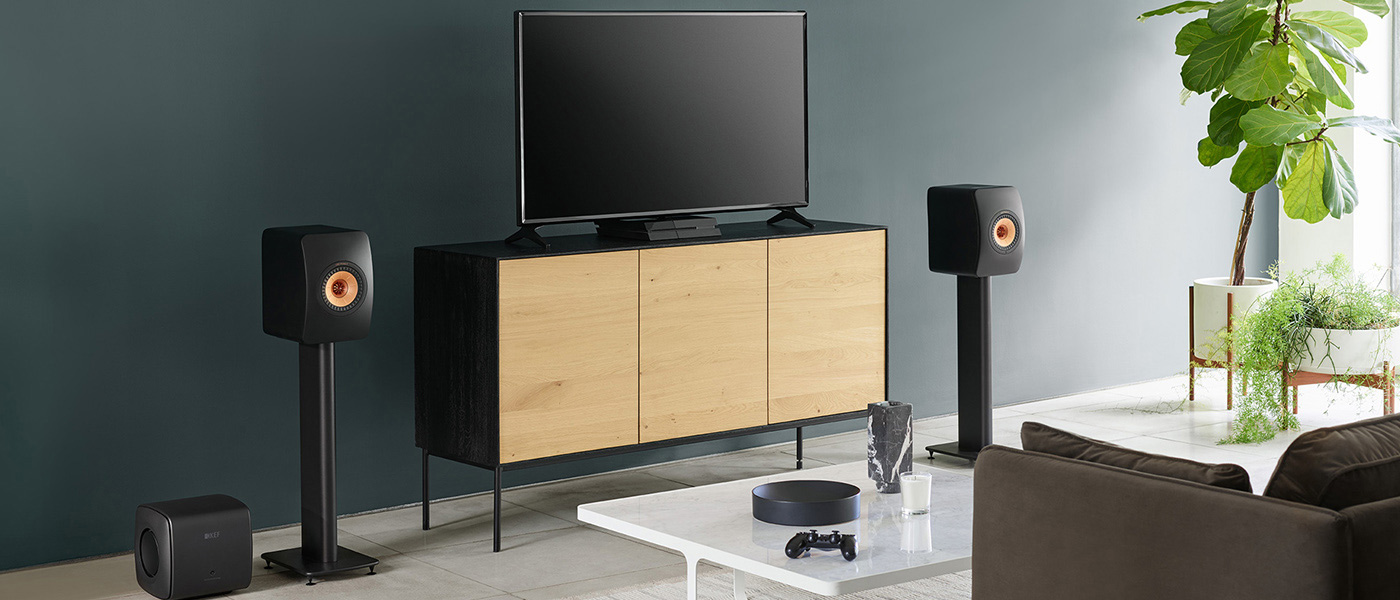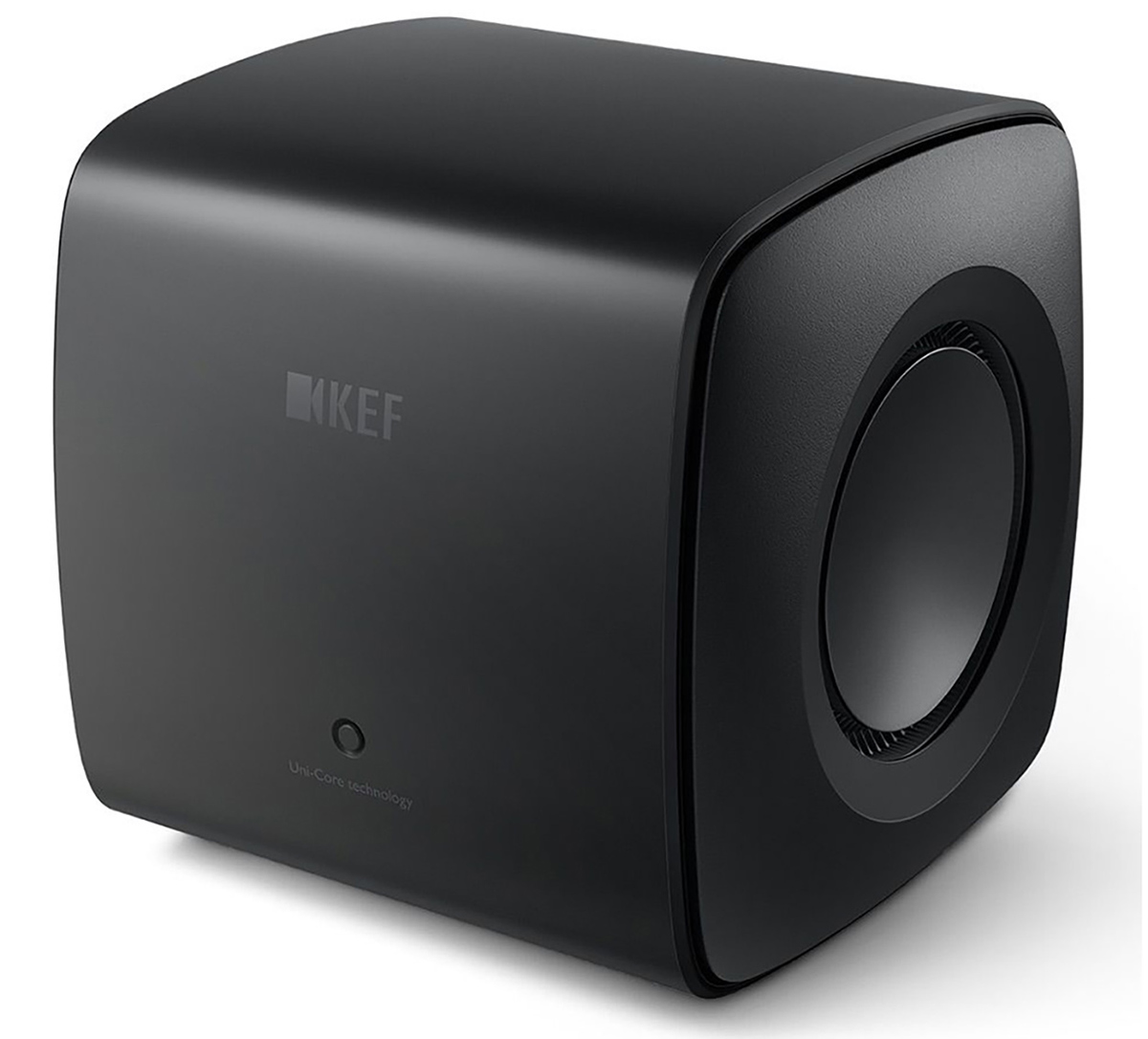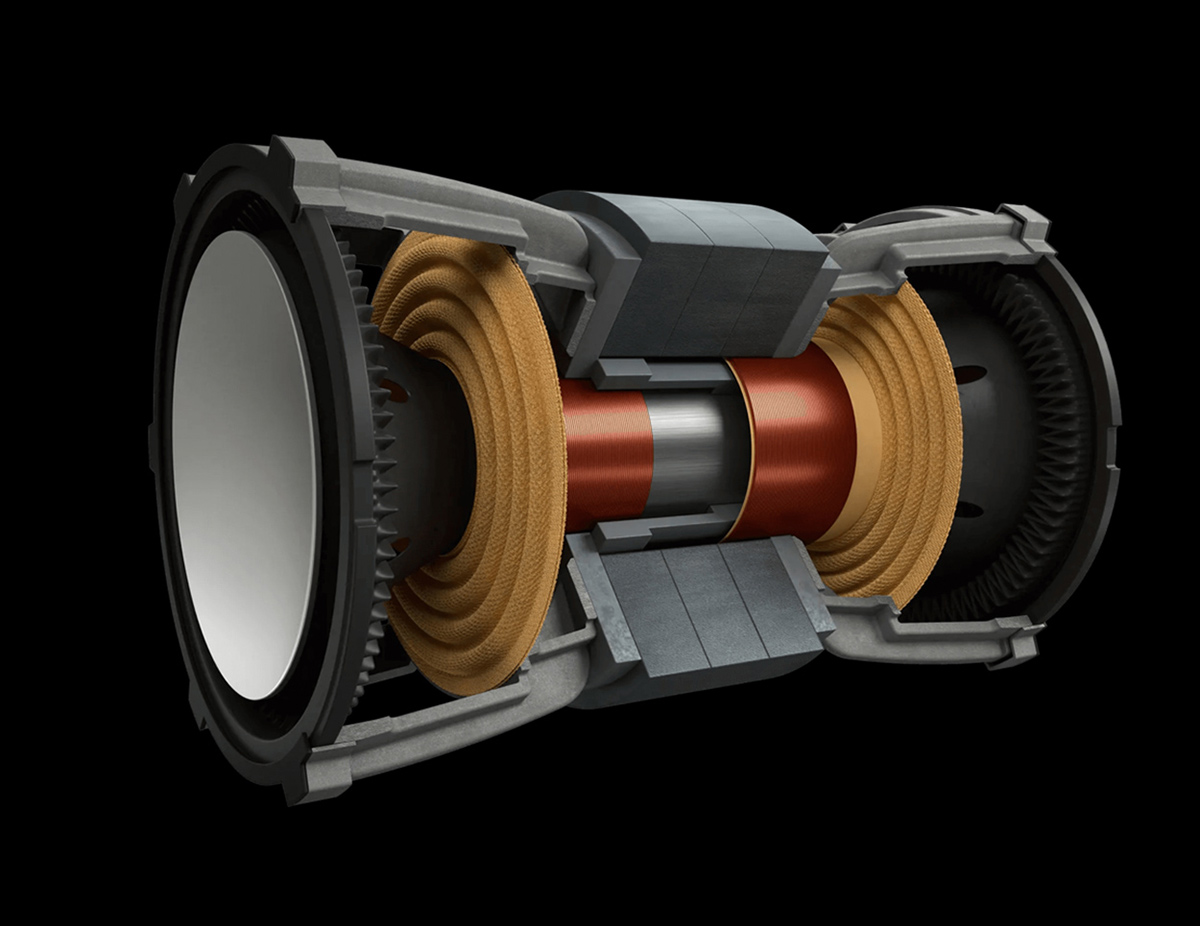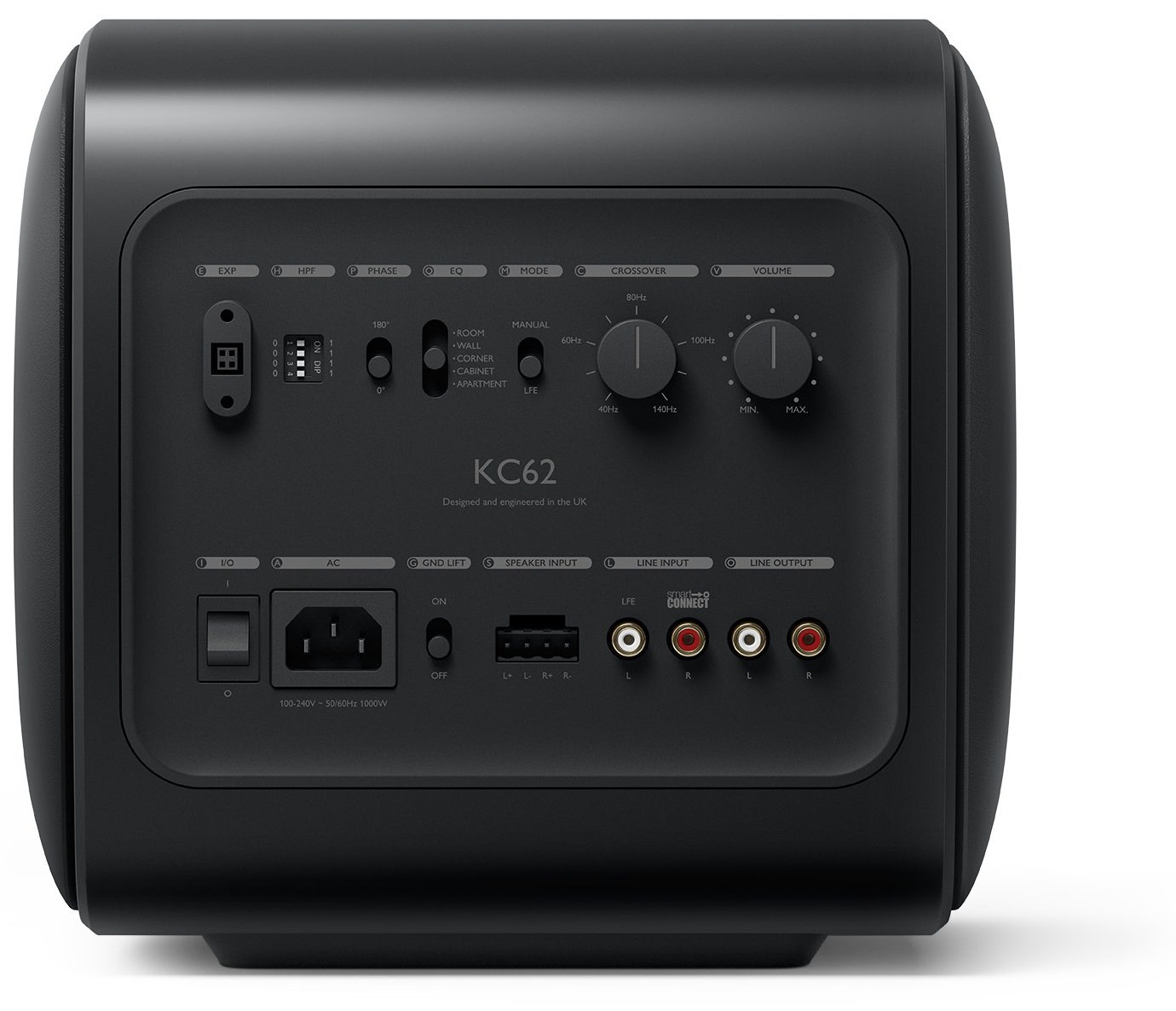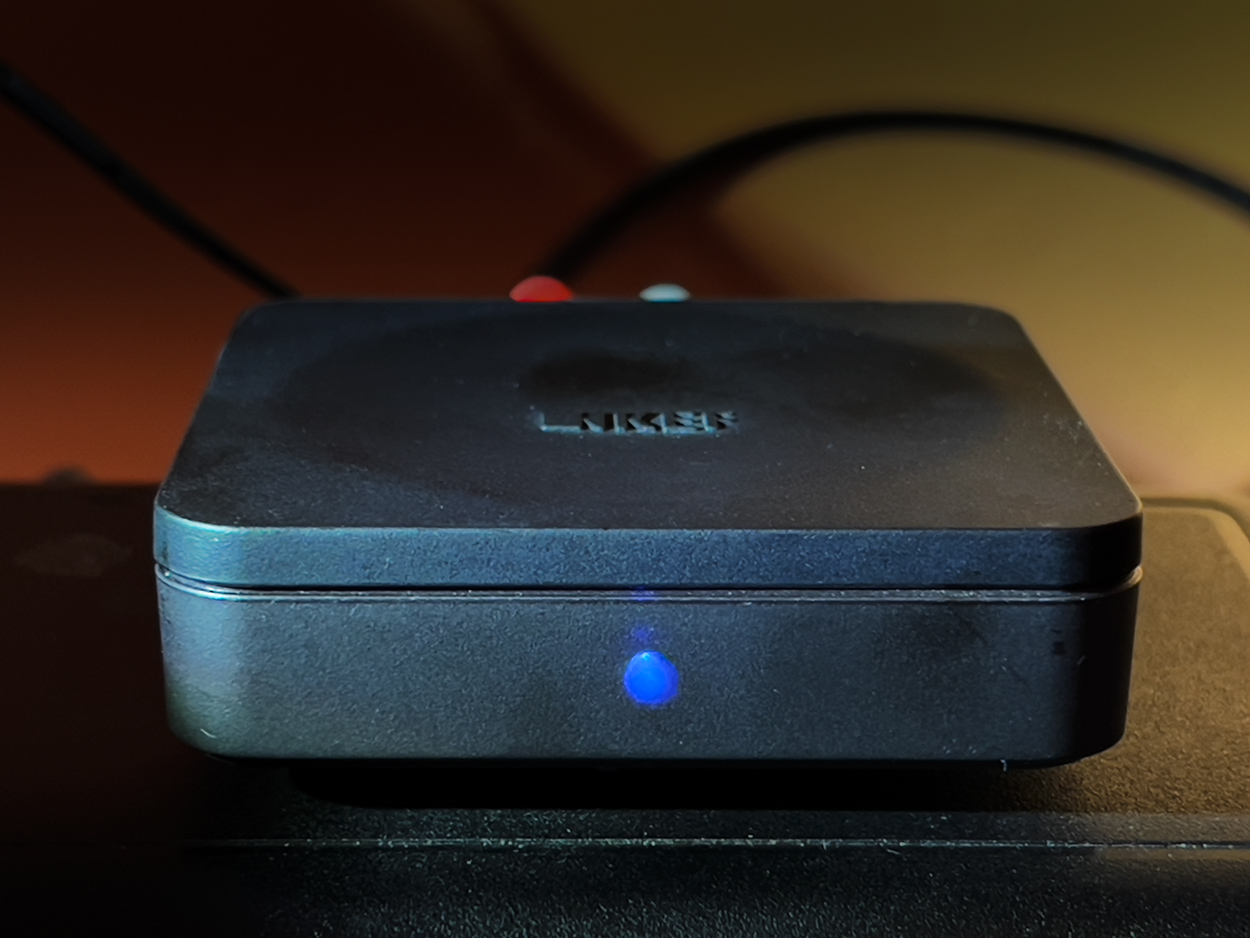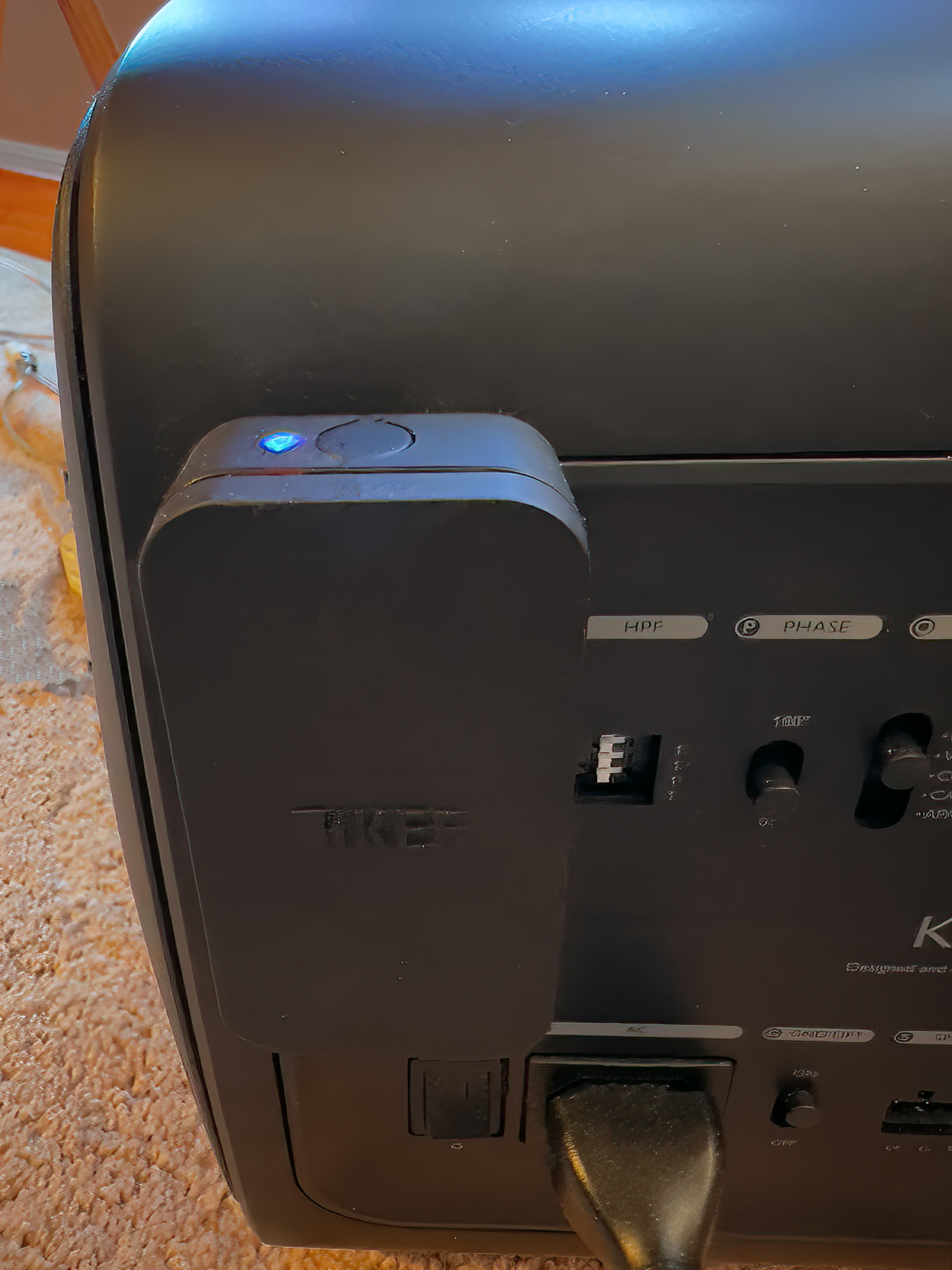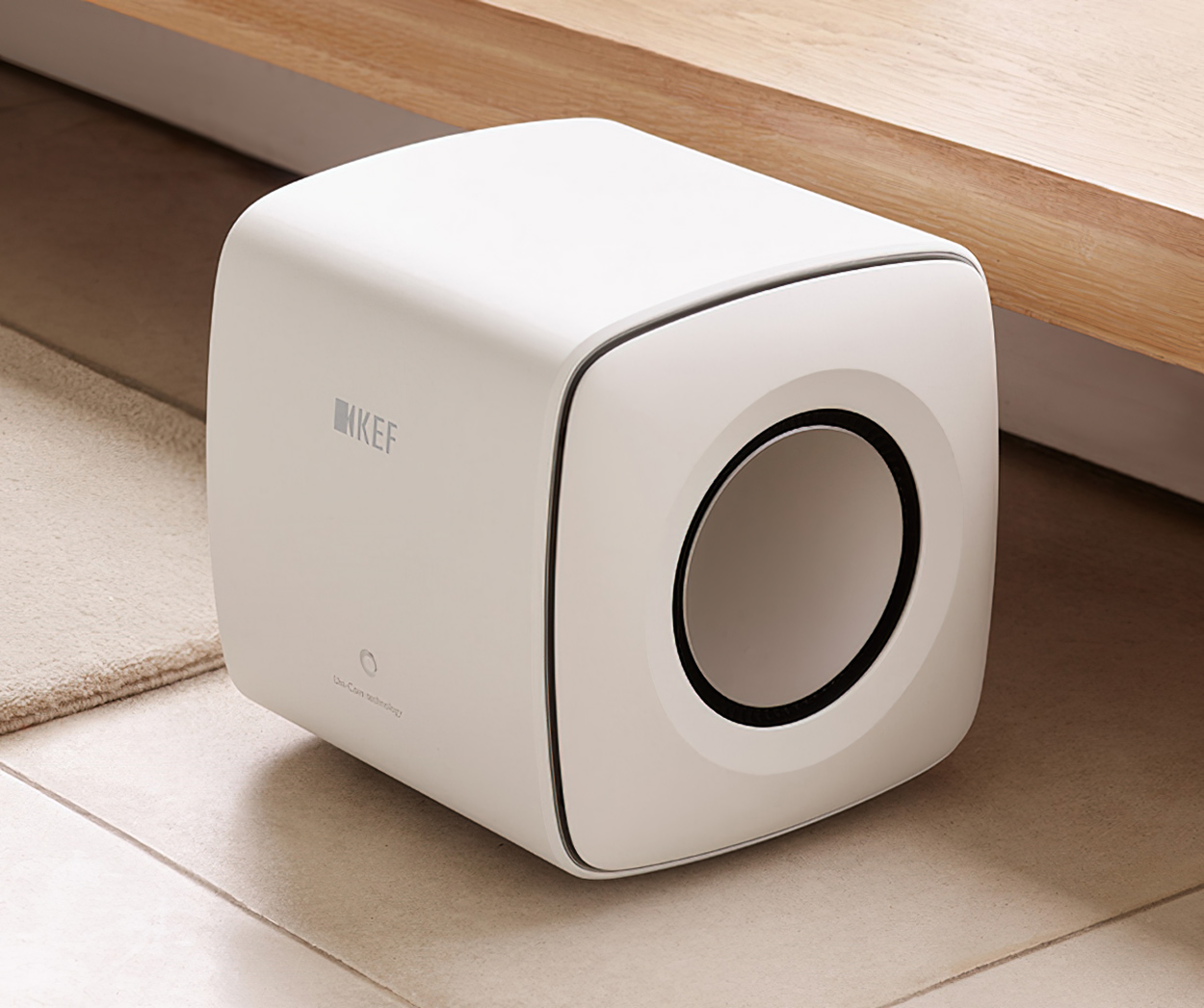Can you get satisfying deep bass from such a small box? KEF put their best engineers on the problem and came up with the KEF KC62 subwoofer. The plain truth is they succeeded in all counts in the right room and with the right high-quality components.
Here’s my summary of what I heard from the KEF KC62 when paired with KEF LS50 speakers, a rather natural pairing of speakers with a similar heritage.
KEF has pulled off deep bass in a small size. Listening in a moderate size bedroom with a pair of LS50s, the sound was solid. If you didn’t see the KC62 down on the floor, you’d never know where the subwoofer was, and you’d think there was a much bigger transducer hidden somewhere. The sub blended perfectly with the LS50 speakers, and the imaging was excellent. The back panel of the KC62 has controls to match the subwoofer position in the room and it adjusts the response curve of the sub to get your desired outcome. I never heard any doubling, driver bottoming out, or distortion, and everything I threw at it, music or movies sounded smooth and deep.
KEF KC62 Subwoofer
- The sound in 2 different rooms was excellent, with deep, distortion-free bass. It complimented the KEF LS50 speakers, but also sounded great in my home theater, which is another smaller room with Focal tower speakers.
- There were no discontinuities from the midrange down to the bass frequencies that I could detect. I heard solid output below 30Hz in both rooms.
- When there was no bass coming from the program material the KC62 was dead silent. No hum to give it away.
- You can use the KEF wired or wirelessly with an optional KW1 accessory.
- I liked the switches to tune the KEF to the room but would’ve preferred continuous settings rather than settings for ‘corner’ or ’wall’.
- Ideally, a remote control would be best so I could make the adjustments from my listening position.
KEF has been around a long time. The KC62 was introduced in 2021. The company was founded in 1961 by Raymond Cooke OBE (1925 – 1995) and was initially headquartered in a Nissen Hut on the premises of Kent Engineering & Foundry (that’s where the name KEF came from), a metal-working company on the banks of the River Medway, near Maidstone in Kent.
Cooke, an ex-BBC Electrical Engineer, was anxious to experiment with new materials and technologies to create products with superior acoustic quality that could reproduce recordings as natural as the original performance. Over the years, KEF has offered high-quality speakers that have been popular with audiophiles and the reviewing press.
Shortly after the announcement of this small subwoofer, I thought it might be a good solution for my bedroom system (KEF LS50 speakers) and in my home theater. Both are small to midsize rooms. My home theater is an extra bedroom turned into a home theater with a Sony ceiling-mounted projector and Focal tower speakers. I’d had some mid-sized, mid-priced subs in both those rooms and found them wanting. They just didn’t go deep enough for my taste, and with movie playback, I found them too thin.
Secrets Sponsor
Many years ago, I tried a Sunfire True Subwoofer Mk II from Carver Corporation. Like the KEF KC62, it was a very small, (11” cube with a 9” driver and a 2700-watt amplifier) long-throw subwoofer. I thought it sounded pretty good in the late 90s, but it wasn’t very reliable, so I moved on to more conventional designs.
I thought Bob Carver was on the right track with the Sunfire, so the KEF KC62 seemed like a great, modern solution for my 2 rooms, so after trying 1 in my bedroom, I sprung for a second KC62.
Design:
Uni-Core Force Cancellation
Drive units:
2 x 6.5 in.
Frequency response:
11Hz – 200Hz
Max output:
105dB
Amplifier type:
Built-in Class-D
Amplifier power:
1000W RMS (2 x 500W RMS)
Variable low pass filter:
40Hz – 140Hz, LFE
Input:
RCA Phono sockets, Speaker level inputs, and a Port for the wireless adapter
Line output:
RCA phono sockets
Line output high pass filter:
40Hz – 120Hz, Bypass
Power requirements:
100 – 240V ~50/60Hz
Power consumption:
1000W
Weight:
14kg (30.9lbs)
Dimensions (H x W x D):
246 x 256 x 248 mm/(9.68 x 10.07 x 9.76 in.)
Price:
$1,500
Website:
Company:
SECRETS Tags:
KEF, KC62, subwoofer, Subwoofer Review 2022
Crafted from extruded aluminum, KC62’s curved cabinet perfectly blends form and function, providing strength and beauty. Small enough to blend into any décor with the option of Carbon Black and Mineral White finishes.
The KC62’s patent-pending Uni-Core™ technology revolutionizes the traditional force canceling design to deliver deep accurate bass from an ultra-compact cabinet. Combining both drivers into a single magnet system allows cabinet size to be reduced by over a third, while also increasing excursion to unlock exceptional output and depth. It’s hard to understate how unique this arrangement is. It’s the result of years of KEF research, and as you’ll read later, it pays off.
KC62’s connection options allow it to be used with almost any audio system, while KEF SmartConnect allows for maximum amplifier output regardless of whether a mono or stereo RCA cable is used. This feature kicks in no matter what brand amplifier is being connected, and speaker-level inputs eliminate any connection issues. Line output with HPF allows for exceptional fine-tuned integration, and the KC62 is also compatible with the KW1 Wireless Subwoofer Adaptor Kit for simple wireless compatibility, which I tested.
The KC62 works well in any environment or listening room, with the five pre-set Room Placement Equalization feature helping to get users similar performance no matter where you decide to place it; in free space, next to the wall, in a corner, placed within an open cabinet or using the dedicated apartment mode which reduces the lowest frequencies to not bother the neighbors.
An array of innovative technologies come together to ensure KC62’s bass accuracy, including the P-Flex surround for precise driver movement and Smart Distortion Control Technology that reduces distortion, while performance is maximized via KEF’s Music Integrity Engine which optimizes the relationship between the amplifier, drivers, and cabinet, while placement-dependent EQ allows for excellent integration into any room.
At the end of the day, the bass is dependent on how much air you move, and that can be done with a large diameter subwoofer, or with a smaller subwoofer with a lot of room to move and with a large amplifier. The KEF KC62 uses two 500-watt RMS Class D amplifiers, and the two 6.5” drivers have a large excursion which can and does produce deep bass.
The only challenge in setting up the KC62 is the weight. It’s 31 lbs., but the small physical size fools you. Imagine 3 bowling balls in a space roughly the size of one.
Besides that, you plug the KC62 into a wall outlet, hook up an RCA cable to your electronics subwoofer output, and you’re just about ready to go. I should note that the KC62 also supports line-level or speaker-level inputs.
Secrets Sponsor
On the back of the speaker are the equalization or room matching adjustments. To start I selected the ‘wall’ setting, as the KC62 was along a wide wall in my room.
If you are using the KEF in a wireless mode and have the optional KW1 adapter, ($199.00) you’ll find there’s a plugin for the adapter, and of course, the wireless kit comes with another small black box that takes the output of your subwoofer channel from your receiver or preamplifier.
The KEF box is powered by USB A, and I plugged it into a spare USB port on my receiver. If you don’t have a handy USB port you’ll need a readily available AC to USB A adapter, which I think should have been included.
When you’re all hooked up there is a blue LED on the box on the transmitter end to let you know the wireless connection has been made. There’s a matching LED on the subwoofer receiver. There is also green (blue – 5.2GHz, green – 5.8GHz). This helps in the event of local interference (Switch channels) or if you want to run stereo wireless subs (use two KW1 systems, one on 5.2GHz, the second on 5.8GHz, and do the same with the receivers on the subwoofer end)
The signal is transmitted at 24bit, 48KHz, so you won’t lose anything versus a wired connection. I could hear no difference in the same program material wired or wireless.
The only negative is that I can’t adjust the subwoofer remotely. I had to keep crawling on the floor and adjust levels and the equalization, then go sit back down in my listening position. I could get great sound, but it would have been faster and easier with app control.
The KEF KC62 surpassed my expectations in every respect. In most rooms, the KC62 is pretty much invisible. However, when you are playing music with deep bass or a movie, the room comes to life with startling clarity. As the saying goes, it’s bass you can feel. My KEF LS50 speakers suddenly sounded like full-range tower speakers. The bass appeared to come from the speaker where the bass notes were originating, and as the frequencies got lower, the bass became more omnidirectional.
I had the same experience listening to my Focal towers in my home theater. They are capable of pretty good bass on their own, but the KC62 added a couple of lower octaves giving movies some very realistic punch.
KEF claims the KC62 can go down to 11Hz. It might be theoretically true, but I can’t hear it and there is no program material that low.
There was plenty of undistorted bass on 32 Hz organ pedal notes, and movies with deep bass like Interstellar probably went even lower. I put some sweep tones into my system, and there was audible sound pressure that I could perceive at 25 Hz. I could feel the subwoofer moving at 20Hz and just hear some hint of bass.
Here’s a sample of some audio and video selections I was impressed with.

Interstellar: As noted above, this movie has very deep bass. It was rendered cleanly by the KC62, without any spurious artifacts.

U571: An OK submarine movie with really punchy bass you can feel when the depth charges go off. The KC62 played these low notes without strain.
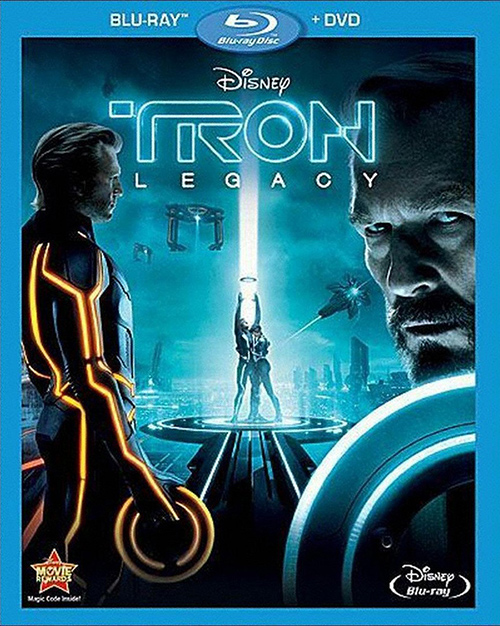
Tron Legacy: Kind of a yawner of a film, but great bass. I also recommend the soundtrack CD or streaming version, especially the track called ‘Disc Wars’.

Flight of the Phoenix: Talking here about the awful remake of the wonderful original with Jimmy Stewart, but when the plane crashes it’s some of the most stunningly realistic sounds you’ll ever hear coming out of your sound system. The bass is incredible. It sounded flawless on the KC62.

Isle of Dogs Soundtrack: Music for a 2018 movie, it’s filled with drums and other percussion instruments. If ever there was a subwoofer test, this is the album. I listened to the 44/16-bit soundtrack.

Traveler – A Journey Symphony: This is an oddball selection, a symphony based on themes from a video game, performed by the London Symphony. Still, it’s a superb recording, a very listenable piece of music, with some very deep bass from cellos and percussion instruments.

Remote Galaxy: Music by Flint Beppe, is one of those wonderful recordings from 2L that offers Blu ray audio, SACD, or CD. Also, the disc contains downloadable files in multiple formats. This is an interesting piece of work, seemingly designed for a good subwoofer. It sounded great with the KC62 rendering the deepest notes with ease.
The KEF KC62 is not inexpensive, and as I’ve said one could buy more with less money. Having said that, the KEF sets up easily in just about any room (my two rooms are very dissimilar in layout and wall treatments, but the KEF KC62 shined in both).
- Construction is solid. The case is inert. Knock on it and there is no resonance.
- Setup is easy using the room eq settings, and the rotary crossover and volume controls.
- The optional KW1 wireless unit is also easy to set up and quickly pairs your source component to the KC62.
- Bass is deep and undistorted.
- I found the KC62 a perfect match for small speakers and tower speakers. In all cases, the low end was significantly improved.
- Setup would be easier if you could make adjustments from the listening position.
- KEF should supply an AC/USB accessory with the KW1 wireless kit.
The KEF KC62 is a first-rate subwoofer for either a straight stereo system or a multi-channel home theater system. It’s specified to get up to 105 dB which is quite loud. Both my rooms are medium to small, so it’s possible in a larger room cranked up really loud it might falter, but when I drove it hard, I would have had to leave the room to tolerate the volume it could cleanly reproduce.
I haven’t heard any of the other well-regarded small subwoofers, and I have no doubt they are excellent. I can say that while expensive, the KEF KC62 certainly punches above its weight, and provided clean, distortion-free deep bass from every subwoofer killer demo I could throw at it. You could spend less on other subs, of course, but I doubt they would equal the breakthrough design and capabilities of something that is so diminutive. Listening to a 15” subwoofer I have in my living room audio system, the KC62 seems to go deeper, but of course, it’s in a smaller, more easily driven room. Still, with the right room and the right high-quality equipment feeding the content, the KEF KC62 is a winner and worthy of your consideration.
In a large room, listening at very loud levels, the laws of physics will take over and the KC62 will run out of amplifier headroom if driven to maximum levels. You’d want large, maybe multiple subwoofers in a situation like that. But for mid to smaller rooms, the KEF sounds superb.
With its small size, very deep undistorted bass, and easy integration with rooms and speakers, the KEF is well worth its price.


